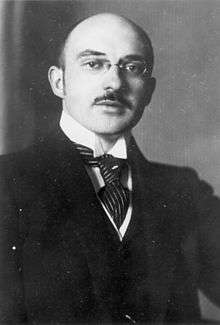Max Erwin von Scheubner-Richter
| Max Erwin von Scheubner-Richter | |
|---|---|
 Max Erwin von Scheubner-Richter |
Ludwig Maximilian Erwin von Scheubner-Richter or Max Scheubner-Richter, born Ludwig Maximilian Erwin Richter (21 January 1884 – 9 November 1923) was an early member of the Nazi Party. Along with Alfred Rosenberg, he devised the plan to drive the German government to revolution through the Beer Hall Putsch. During the Putsch, he was shot in the lungs and died instantly, at the same time dislocating Hitler's right shoulder.
Early life
Scheubner-Richter was a Baltic German born in Riga, Livonia and lived a large part of his life in the Russian Empire. During the Russian Revolution of 1905 he belonged to one of the private armies set up to fight against the revolutionaries. He married the daughter of a manufacturer whose factory he had guarded. The 'Scheubner' in his surname was prefixed to his own from his wife's family name: an old German form of having one's lineage ennobled.
World War I and Armenian Genocide
During the First World War, Scheubner-Richter served in Ottoman Turkey as the German vice consul of Erzerum. In addition to holding that post, he also documented the Turkish massacres of Armenians as part of the Armenian Genocide.[1] At the time, he was considered one of the most outspoken individuals against the deportations and subsequent massacres of Armenians.[2] Scheubner-Richter believed that the deportations were based on "racial hatred" and that none could survive such a journey.[3][4] He concluded that the deportations were a policy of "annihilation".[5]
Russian Revolution
After the war he was involved in the Russian counter-revolution.
Germany (1918-1923): Nazi activity
Scheubner-Richter moved to Germany from Russia along with Alfred Rosenberg in 1918. He was the leader of the Aufbau Vereinigung, a conspiratorial organisation, composed of White Russian émigrés and völkisch-minded German National Socialists.[6]
At the end of September 1923, Scheubner-Richter provided Hitler with a lengthy plan for revolution, writing: "The national revolution must not precede the seizure of political power; the seizure of the state's police power constitutes the promise for the national revolution" and "to lay hands on the state police power in a way that is at least outwardly legal".[7]
During the Beer Hall Putsch, walking arm-in-arm with Hitler, he was shot in the lungs and died instantly as Hitler and others marched toward armed guards on 9 November 1923.[8] He had brought Hitler down and dislocated Hitler's right shoulder when he fell. He was the only first-tier Nazi leader to die during the Putsch. Of all the early party members who died in the Putsch, Adolf Hitler had claimed Scheubner-Richter to be the only "irreplaceable loss".[9] The first part of Hitler's book Mein Kampf is dedicated to Scheubner-Richter and the other fifteen men who died in the Putsch.
See also
References
- ↑ Akcam, Taner. A Shameful Act: The Armenian Genocide and the Question of Turkish Responsibility. New York: Metropolitan, 2006 pp. 121, 156, 158 ISBN 0-8050-8665-X
- ↑ Smythe, Dana Renee (2001). Remembering the forgotten genocide: Armenia in the First World War. East Tennessee State University. p. 81. ISBN 0-493-30243-3.
- ↑ Charney, Israel (1994). The Widening Circle of Genocide. W. W. Norton & Company. p. 107. ISBN 1-4128-3965-3.
- ↑ Leverkuehn, Paul (2008). A German officer during the Armenian genocide: a biography of Max von Scheubner-Richter. translated by Alasdair Lean; with a preface by Jorge Vartparonian and a historical introduction by Hilmar Kaiser. London: Taderon Press for the Gomidas Institute. ISBN 1-903656-81-8.
- ↑ Herwig, Holger (10 Feb 2007). "Documenting a 'shameful act': Turkish emigre historian writes on Armenian genocide". The Gazette. Montreal. p. J5.
Interestingly, Max von Scheubner-Richter as German vice-consul at Erzerum in 1915 reported the Ottoman policy of "annihilation" of the Armenians to his government; as a Nazi ideologue, he died at Adolf Hitler's side during the infamous "Beer Hall putsch" of November 1923.
- ↑ Michael Kellogg, The Russian Roots of Nazism: White Émigrés and the Making of National Socialism, 1917–1945, Cambridge University Press, 2005, ISBN 9780521070058
- ↑ Heiden, Konrad. Der Fuehrer: Hitler's Rise to Power. New York: Houghton Mifflin Co, 1944 p. 184
- ↑ Toland, John. Adolf Hitler: The Definitive Biography. New York: Anchor Books, 1976 p. 170 ISBN 0-385-42053-6
- ↑ Balakian, Peter. The Burning Tigris: The Armenian Genocide and America's Response. New York, HarperCollins, 2003 p. 407 ISBN 0-06-055870-9